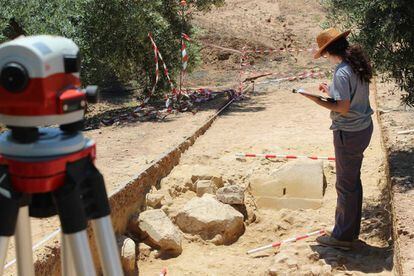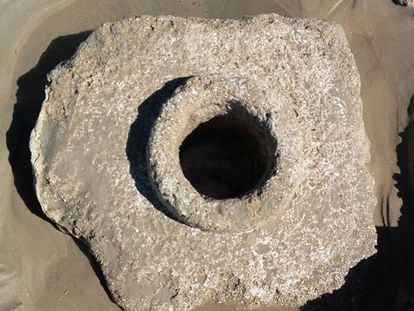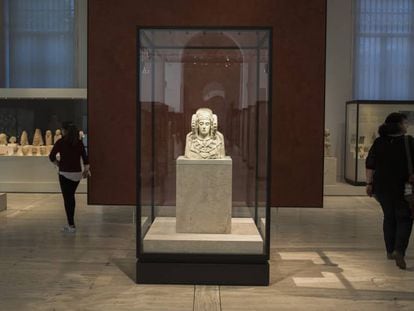Spain’s raiders of the lost arch
The discovery in the Jaén countryside of the starting point of the 1,500-kilometer-long main Roman road in Andalusia is being described as “one of the most important in the last few decades”


The two bases of the Janus Augustus Arch have been unearthed in the Jaén countryside and are set to alter the way we perceive Andalusia’s Roman past.
This imposing structure, some seven meters high, four meters deep and 15 meters wide, was built from local sandstone in the era of the Emperor Augustus and cemented with Roman concrete, and was “kilometer zero,” i.e. the starting point, for the 1,500-kilometer-long main Roman road in Andalusia, then known as Hispania Baetica. Twenty-one centuries later, the discovery allows a glimpse into the people who crossed under the ancient arch in what is now the city of Mengíbar.
These are the remains of a Roman road that has lasted 2,000 yearsUJA researcher Juan Pedro Bellón<br />
“Thanks to this find, you can pinpoint down to the last centimeter where you are on the Via Augusta – the main road through Baetic Hispania that leads to Rome in one direction and to the Atlantic in Cádiz in the other. It was a way of measuring distance and a reference point,” says Juan Pedro Bellón, researcher and head of the Iliturgi Project at Jaén Univeristy (UJA) whose team has already taken steps to request the area be declared a National Heritage Site.
“This is not simply of local significance,” he adds.“It has international repercussions. These are the remains of a Roman road that has lasted 2,000 years and we want to raise awareness of its significance. If it’s not properly protected, a tractor could remove it in no time.”
Investigadores del Instituto Universitario de Investigación de Arqueología Íbera de la @ujaen han localizado el ‘Jano Augusto’ (Ianus Augustus), en el municipio de #Mengíbar
— Universidad de Jaén (@ujaen) May 22, 2018
Más información en https://t.co/kIy4CZGwgG pic.twitter.com/GShYph5wW6
Researchers from the University Institute of Iberian Archeological Research of the @ujaen have located the Janus Augustus in #Mengíbar
More information in https://bit.ly/2ICDgRW
The find has allowed researchers to rethink their vision of the past, including distances, historical moments and other details that combine to illustrate the High Guadalquivir’s importance to Rome – putting it on a par with other sites such as the cities of Iliturgi and Castulo. “There are scarcely any maps or bibliographic sources with which to situate this enclave,” says Bellón. “The last reference is from the Islamic period when a camp called Arco was established.”
Bellón suggests the significance of such monuments was close to symbolic, since they marked borders and served as testaments to power and influence in the area. “It’s interesting too to think that people would have carried out certain rituals here in order to cross the border,” says Bellón. “This arch marked a sacred frontier in the area and there would have been an awareness of crossing this.”
There is still work to do. Bellón and his team have to now study and evaluate the site and its artifacts. “We are still hopeful that we will find a temple in the area and inscriptions from the arch. So far, we have found ornamental remains and decorative vegetable molds,” says Bellón, who believes the remains of the arch could have been dug up previously to construct the Mengibar Tower, which formed part of the ancient Arabic fort here in the 13th century.
This arch marked a sacred frontier in the area UJA researcher Juan Pedro Bellón
This, of course, is not the first expedition that has gone in search of the arch. A team from the German Archeological Institute made a series of attempts to find it nearby.
“Its discovery will solve many mysteries concerning the Romans’ past in Andalusia and, as a point of reference, will also help to clear up doubts over ancient geography,” says María Dolores Rincón, Jaén University’s vice rector, who is in charge of promoting culture and sport.
According to Manuel Molinos, director of the University Institute of Iberian Archeological Research of the UJA, “it’s being called one of the most important discoveries in the last few decades as it relates to the end of the Iberian world and the start of Rome’s presence.”
English version by Heather Galloway.












































